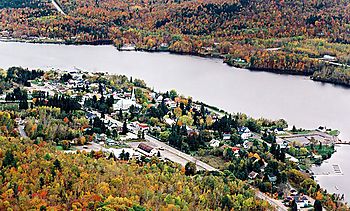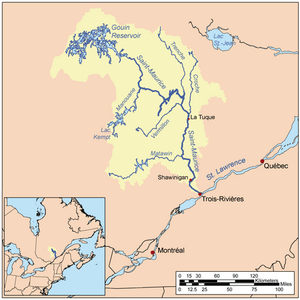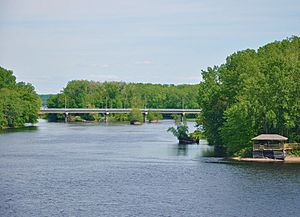Saint-Maurice River facts for kids
Quick facts for kids Saint-Maurice River |
|
|---|---|

Saint-Maurice River at Grandes-Piles
|
|
 |
|
| Native name | Rivière Saint-Maurice |
| Other name(s) | Tapiskwan sipi |
| Country | |
| Province | |
| Region | Mauricie |
| Physical characteristics | |
| Main source | Gouin Reservoir 404 m (1,325 ft) 48°21′15″N 74°06′00″W / 48.35417°N 74.10000°W |
| River mouth | Saint Lawrence River Trois-Rivières 3 m (9.8 ft) 46°20′55″N 72°31′40″W / 46.34861°N 72.52778°W |
| Length | 563 km (350 mi) |
| Basin features | |
| Basin size | 43,300 km2 (16,700 sq mi) |
The Saint-Maurice River is a big river in central Quebec, Canada. It flows from north to south, starting at the Gouin Reservoir. The river ends by emptying into the Saint Lawrence River at Trois-Rivières.
The Saint-Maurice River is about 563 kilometers (350 miles) long. Its drainage basin, which is the area of land that collects water for the river, covers 43,300 square kilometers (16,700 sq. miles). This makes it one of the most important rivers that flow into the Saint Lawrence River. From its source, the river drops about 405 meters (1,330 feet) in height.
Long ago, fur traders used the river to travel. Later, in the 1800s, logging became a major industry. For most of the 1900s, the river helped transport logs to sawmills. Today, it is still a very important source of hydroelectric power. This means it helps make electricity using the force of its water.
The river was the first way to travel in this area. Native Americans used it long before Europeans arrived. Explorers and trappers also used it as a main route in Quebec. Many towns grew up along its banks. These towns used the river's power to build dams and power stations. Some well-known cities along the river include La Tuque, Shawinigan, and Trois-Rivières.
Contents
What's in a Name? The River's History

The Saint-Maurice River has had several names over time. The Algonquin people first called it "Métabéroutin." This name means "discharge of the wind." The Atikamekw people of Haute-Mauricie still call it "Sipi Tapiskwan." This means "river of the threaded needle." The Abenaki people called it "Madôbaladenitekw," or "the river that ends."
In 1535, explorer Jacques Cartier named it "River Fouez." He did this to honor the House of Foix. However, this name was not used much after the early 1600s. It was then called "Three Rivers."
The river got its current name in the early 1700s. This name comes from the "fief of Saint-Maurice." A fief was a piece of land given to someone by a lord. This land was on the west bank of the river. It was given around 1668 to Maurice Poulin in La Fontaine. He owned some land along the river in the 1600s. The name "St. Maurice" was first written down in 1723. It fully replaced "Three Rivers" between 1730 and 1740. The river also gave its name to the Mauricie region.
Cities and Towns Along the River
Many communities are located along the Saint-Maurice River. They are listed here from the mouth of the river (where it meets the Saint Lawrence) going upstream:
- Trois-Rivières
- Shawinigan
- Grand-Mère
- Grandes-Piles
- Saint-Roch-de-Mékinac
- Grand-Anse (hamlet)
- Rivière Matawin (hamlet)
- Rivière-aux-Rats (hamlet)
- La Tuque
- Wemotaci
- Sanmaur
Bridges and Crossings
Many bridges and other structures cross the Saint-Maurice River. They help people and trains get from one side to the other. Here are some of them, listed from downstream (near Trois-Rivières) to upstream:
Crossings in Trois-Rivières
- Railway Bridge Railway Quebec-Gatineau (connects east bank to island Pottery)
- Bridge (links Saint-Quentin Island to Saint-Christophe Island)
- Bridge (links Caron island to Saint-Christophe Island)
- Duplessis Bridge
- Railroad Bridge Railway Quebec-Gatineau
- Radisson Bridge
- La Gabelle Generating Station (links Saint-Étienne-des-Grès to Notre-Dame-du-Mont-Carmel)
- Railway Bridge Railway Quebec-Gatineau (links Saint-Étienne-des-Grès to Notre-Dame-du-Mont-Carmel)
Crossings in Shawinigan Area
- Railway Bridge Railway Quebec-Gatineau (links Shawinigan-Sud to Shawinigan)
- Marc Trudel Bridge
- Shawinigan Bridge
- Banana Bridge (links "Île Banane" to Melville Island)
- CNR Railway Bridge (links the two shores)
- Grand-Mère Bridge
- Bac (a ferry for bicycles and pedestrians)
- Bridge of Piles
- Bac (a ferry for bicycles and pedestrians from Shawinigan to Grandes-Piles)
- Bridge Mekinac (links Lac-Normand to Trois-Rives)
Crossings in La Tuque Area
- Bridge of Rivière-aux-Rats
- La Tuque Generating Station
- La Tuque West shore bride
- Rivière-au-Lait bridge
- Beaumont generating station
- La Trenche Generating Station
- Rapide-Blanc bridge
- Rapide-Blanc Generating Station
- Rapides-des-Coeurs Generating Station
- CNR Railway Bridge (links the two shores)
- Chute-Allard Generating Station
- CNR Railway Bridge (links the two shores at Wemotaci)
- Wemotaci bridge (links the two shores at Wemotaci)
- La Loutre Bridge (links the two shores)
- Gouin Dam
Hydroelectric Power Plants and Dams
The Saint-Maurice River is home to several hydroelectric power stations and dams. These facilities use the river's flow to create electricity. All of these power plants are owned by Hydro-Québec. They are listed from downstream to upstream:
- La Gabelle Generating Station
- Shawinigan-2 Generating Station and Shawinigan-3 Generating Station (at the same falls)
- Rocher-de-Grand-Mère Generating Station and Grand-Mère Generating Station (at the same falls)
- La Tuque Generating Station
- Beaumont generating station
- La Trenche Generating Station
- Rapide-Blanc Generating Station
- Rapides-des-Coeurs Generating Station
- Chute-Allard Generating Station
- Gouin Dam
Timber Transportation on the River
For almost 150 years, the Saint-Maurice River was used to transport timber. This process is called "timber flotation." Logs were floated down the river from forests to mills. In 1996, the Saint-Maurice River was the last river in Quebec to stop this practice.
Each spring, workers would clean the river banks. They would free logs that got stuck on the shores or rocks. These logs were then sent downstream to paper mills.
Fish and Wildlife in the River
Experts have studied the fish in the Saint-Maurice River. In the last 174 kilometers (108 miles) of the river, between Trois-Rivières and La Tuque, they found 42 different kinds of fish.
The number of fish in the river is generally low. This is common for rivers in the Canadian Shield region.
See also
 In Spanish: Río Saint-Maurice para niños
In Spanish: Río Saint-Maurice para niños

